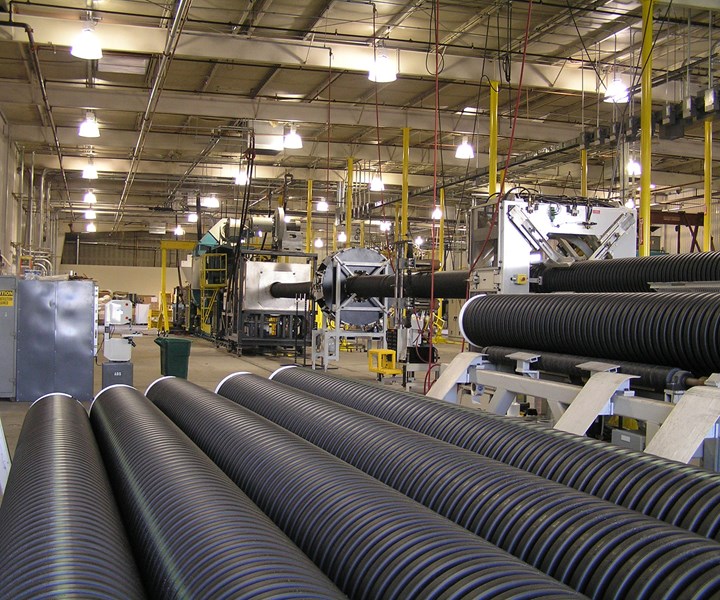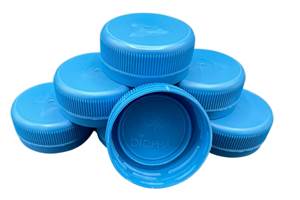Blazing the Trail In Processing PCR for Corrugated Pipe
Just a decade ago, roughly 10% of HDPE corrugated pipes made by Advanced Drainage Systems used recycled material. That number is 65% now, and growing. Here’s how this processor became a pioneer in this field.
When you think of words like recycling, sustainability, and circular economy, corrugated pipe likely doesn’t spring to mind right away. The focus instead is in far-more visible plastics applications—notably single-use packaging—as brand owners, processors and the rest of the supply chain search for solutions that turn old plastics new again.
But if recycling is on your must-do list, most likely you can learn something from the 30-yr path blazed by Advanced Drainage Systems (ADS) that has made this producer of corrugated pipe one of the largest consumers of recycled HDPE in the U.S. Some 60% of the pipe it produces now has recycled content— up from 24% 10 years ago—a figure it expects to grow.
Headquartered in Hilliard, Ohio, ADS is a leading producer of high-performance corrugated pipe—most of which is HDPE-based—used across a wide range of end markets and applications, including non-residential, residential, agriculture and infrastructure. The company was founded in 1966 with the premise that corrugated polyethylene pipe was a better solution than standard clay and steel drainage pipe, and it set about convincing agricultural, commercial and industrial markets that it was right.
Today, ADS is a publicly traded company with $1.385 billion in sales for fiscal year 2019 and roughly 60 manufacturing plants in the U.S. The company estimates that more than 8.5 billion ft of its pipe are in service around the world—from major construction sites with drainage requirements to residences.

ADS is a leader in HDPE corrugated pipe production and last year consumed 400 million lb of PCR.
You might try to argue that a recycling venture with post-consumer HDPE as a feedstock is no extraordinary achievement considering that the infrastructure for reclaiming HDPE is well in place. But that would ignore ADS’s forward-thinking strategy of solving a problem before it became a problem. The drainage-pipe maker started looking at HDPE recycling streams in the early 1980s, a nascent period of plastics recycling, and in effect was a driver in creating a secondary market for milk jugs, detergent bottles and the like.

Feedstock material in bales at ADS’ Green Line Polymers recycling business.
Comments Dan Figola, ADS’s director of sustainability, “From the start, we focused a lot on the technology and science of recycling, trying to understand these materials on the molecular level, how using them influenced end-product performance and service life. We started studying various blending technologies, studying how we could manage product performance by adjusting the amount, quality, and type of PCR we used, and what we blended it with.”
Since 2007, ADS has been issued more than 30 patents in the area of recycling. And through it’s recycling journey, it literally set the standard for how post-consumer HDPE can be deployed in corrugated pipe, working with industry groups such as ASTM International and the American Association of State Highway and Transportation Officials (AASHTO) to develop industry guidelines.
ADS used more than 400 million lb of recycled material in its products last year. That figure looks to increase beyond 550 million lb this year by virtue of last summer’s acquisition of Infiltrator Water Technologies. This Connecticut-based company produces plastic products for waste-water-treatment, including leach-field chambers and systems and septic tanks and accessories, primarily for use in residential applications. Through sister company Champion Polymer Recycling, Infiltrator runs about 150 million lb of post-consumer and post-industrial HDPE every year.
“We started studying various blending technologies and how we could manipulate product performance by adjusting the amount of PCR we used and what we blended it with.”
ADS started recycling by buying scrap from third parties, including other processors. But in 2012, it opened a recycling enterprise of its own, Green Line Polymers. Green Line has nine recycling plants across the country, handling both post-consumer and post-industrial scrap. Baled material is sorted, ground, washed and pelletized, and sent to one of ADS’s plants or sold to other processors for non-pipe applications. “We try to tap into a wide range of different HDPE products,” notes Jeff Biesenberger, ADS’ director of materials engineering. “These include Number Two, mixed-color bales purchased from MRFs, which are mostly bottles.”

ADS has a wide range of lab instruments to test properties of incoming materials, critical since it blends reclaim to virgin materials and additives to achieve the properties the application requires.
It’s All in the Mix
Both Green Line Polymers and ADS have fully equipped labs to test both incoming materials and finished product to ensure they are kept up to spec. “Every lot from Green Polymers is tested,” states Biesenberger. “You have to remember that our product line is limited in the amount of contamination we can accept. We’re not making thick parts like parking stops. Some of our products have 0.012-in. wall thickness.”
“You have to remember that our product line is limited in amount of contamination we can accept. We’re not making thick parts like parking stops.
To support its focus on blending to achieve the desired properties, ADS engineered and built its own blending and recipe-optimization package, called—appropriately enough—the Optimizer. Notes Figola, “From our lab tests of density, melt-flow rate, impact strength, moisture and more, we know the limits of all the materials we use, as we developed mathematical models to help balance and optimize the blend.”
ADS production lines are equipped with gravimetric blending that can accommodate up to six material streams. The pipe producer has coextrusion capability but opts not to bury its scrap in core layers, Biesenberger says. The amount of PCR in ADS pipes range from zero—in some applications, regulations and codes require all-virgin structures—to 100%, with lots of wiggle room in between. Single-wall pipe in general uses the highest amount of PCR.
One of ADS’ hallmark products is its dual-wall Mega Green HDPE pipe that has a minimum recycled-material content of 60%. Mega Green meets ASTM F2648 and provides a smooth interior (for hydraulic efficiency) and annular exterior corrugations. Light weight, with a bell-and-spigot joint design and in-line bell design, the pipe is billed as a Green Building product that can be used in a variety of environmentally conscious projects. Some applications include storm sewers, mining, forestry, industrial waterways, golf, turf and recreation, grain aeration, land reclamation and ditch enclosures.
Says Tori Durliat, ADS’ director of marketing, “The reason we started looking at recycling so many years ago, and the reason we are so heavily invested in it now, is because it's the right thing to do.” Adds Figola, “Everyone is concerned about recycling initiatives in packaging. HDPE is widely accepted in pipe, and we still have a huge appetite for reclaimed material. Ours is the ideal solution, the ideal home, for extending the lifecycle of plastics.”
Related Content
Looking to Run More Regrind? PTXPO Workshop Tackles How
When it comes to making injection molding operations more sustainable, the lowest hanging fruit is the use of regrind, but that doesn’t mean it’s not without challenges.
Read MoreProcessors: Gear Up to Handle More Regrind
Plastics auxiliary and primary processing equipment was optimized for running pellets; here’s how you can adjust to the bulk density differences of flake and regrind in drying, conveying, mixing, feeding and processing.
Read MorePHA Compound Molded into “World’s First” Biodegradable Bottle Closures
Beyond Plastic and partners have created a certified biodegradable PHA compound that can be injection molded into 38-mm closures in a sub 6-second cycle from a multicavity hot runner tool.
Read MoreICIS Launches: Ask ICIS Generative AI Commodities Assistant
Said to be the first of its kind, this AI assistant will enhance access to ICIS’ intelligence and insights for the energy and chemical markets.
Read MoreRead Next
People 4.0 – How to Get Buy-In from Your Staff for Industry 4.0 Systems
Implementing a production monitoring system as the foundation of a ‘smart factory’ is about integrating people with new technology as much as it is about integrating machines and computers. Here are tips from a company that has gone through the process.
Read MoreLead the Conversation, Change the Conversation
Coverage of single-use plastics can be both misleading and demoralizing. Here are 10 tips for changing the perception of the plastics industry at your company and in your community.
Read More



























